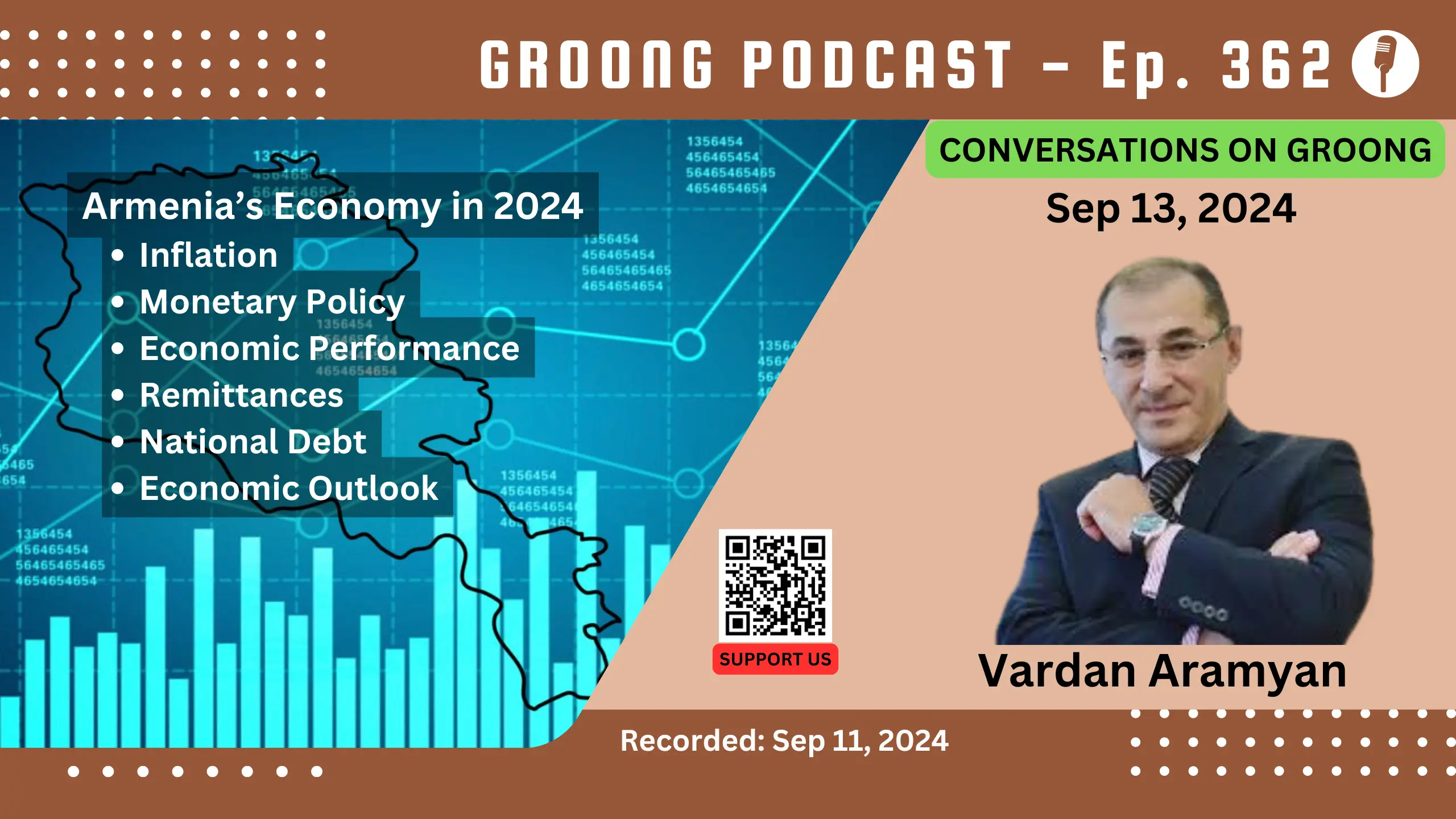
Groong Links:
Guest:
- Mr. Vardan Aramyan - Fmr. Minister of Finance, Republic of Armenia
Topics:
- Inflation
- Monetary Policy
- Economic Performance
- Remittances
- National Debt
- Economic Outlook
- References
Episode 362 | Recorded: Septemberr 11, 2024
Show Notes
Armenia’s Economy in 2024
Inflation
Let’s start in a place where the news is not so bad at least on paper, and from where most people’s impressions come from about the economy: Inflation.
Armenia was subject to the same global inflationary currents as everyone else after the Covid pandemic, and experienced 10% plus inflation rates until early 2023. For most of 2024 reported inflation has been essentially zero, with the first 7 months recording -0.3% inflation. So a slight amount of price deflation at the consumer level. The producer price index is at 2.8%, perhaps showing a modest amount of inflation in the pipeline.
However, when you talk to people on the street, many would disagree that the economy is good, and cite increased prices for food and other basic items.
Questions:
- What’s your read of how Armenia is managing its inflation?
- Can you explain why consumers are not feeling the so-called “good economy” in their own pocketbooks and lives?
- What are the key factors that affect inflationary and deflationary pressures in the Armenian economy?
- For example in the US housing shortages can affect housing prices, or wage inflation can lead to prolonged inflationary trends. What factors are major influencers in Armenia?
Monetary Policy
In July the Armenian Central bank lowered the refinancing rate to 7.75%. Meanwhile, the Dram has appreciated from the start of the year, when it was around 405 to the dollar, to these days at 387 to the dollar. (Around a 4.6% appreciation)
Questions:
- Is a refinancing rate of 7.75% where we need to be for optimal economic growth?
- Why is there such a big gap between the refinancing rate offered by the central bank to commercial banks and the average interest rate charged by banks? Is this a regulation problem or a risk management problem? (Banks have been super-profitable lately)
- Countries such as France, Germany, and Japan have a relatively high amount of regulations that control how much banks can mark up the commercial interest rates. How would you grade Armenia in the amount of regulation it exercises?
- What’s fueling the apparent stability and even a not insignificant appreciation of the Dram rate?
Guest Workers and Remittances
In April, Armenian banks stopped servicing the Russian “Mir” payment card system. The government also reports a significant drop in remittances to Armenia. Money transfers from Russia decreased by 69.4%, while overall remittances decreased by 48%.
Questions:
- What do you attribute this drop in remittances to?
- What effect can such a drop have on the Dram rate?
Traditionally, a large number of Armenian men go to Russia to earn money each year, and then return in the winter. More recently, Armenia has become a destination for Indian labor.
Questions:
- How are migration dynamics affecting remittances, wages, and money flow in and out of Armenia?
- Are there labor shortages in Armenia? And what do you attribute it to?
- What does Armenia need to do in order to reduce its reliance on remittances?
- I mean it doesn’t seem like it’s something one can rely on; remittances are personal level transmissions, and not taxable financial transactions.
Economic Performance
According to the current minister of finance, Vahe Hovannisyan, Armenia recorded 10.4% economic growth in the first half of 2024, but he expects that the full year 2024 growth will be closer to 6%. If you look at the month over month numbers, the growth rate is already slowing down.
When we look at the ministry’s H1/2024 report on the economy, we see that there is a re-export economy on steroids, primarily raw gold and some precious stones, for which Armenia is basically a flyover or flythrough country.
Outside of this re-export economy, there are a lot of weak spots in various sectors: Agriculture, Armenian Brandy, tourism, even a 13% slowdown in the IT industry.
We’re including a summary of the numbers in the show notes HERE.
Question:
- Why is there an ongoing slowdown to the economy?
- What’s the re-export business for us?
- How is this not being noticed by the “sanctions police”?
The government has come under criticism for poor planning of its capital and operational expenditures and revenues. There are large discrepancies, and the finance minister has tried to explain them away.
Questions:
- What’s the reason why the government is not hitting its marks in projected revenues and expenditures?
- The minister pointed to a “reserve fund”, which this year contained 55 billion Drams. Is this a government emergency fund, what is it for?
- Note: I’m specifically wondering why the government called for international aid during the floods in the north, instead of jumping in with the emergency/reserve fund.
The National Debt
Armenia’s national debt has recently hit around $12.5B, and stands around 51% of GDP. In March of 2019 the national debt was around $5.5B, although then also it was a little over 50% of GDP.
Questions:
- 50% national debt-to-GDP is not a scary number for a healthy economy. But given the re-export aspect of this economy, is the GDP number being used a reliable indicator for the size of the Armenian economy?
- Is Armenia’s national debt too large?
Economic Outlook
The S&P sovereign rating for Armenia remained unchanged at BB-/B.
Questions:
- What’s your outlook for the economy for the balance of 2024?
- How would you rate the management of the Armenian economy?
- What do you see as the risks to the Armenian economy?
References
- Armenia’s economic indicators maintain growth in January-July
- The sovereign rating of Armenia has been published
- Առաջին յոթ ամիսներին տնտեսական ակտիվության ցուցանիշը կազմել է 9.6%
- 2024 in the first half of the year, both revenues and expenditures of the state budget were underachieved. “LUYS” Foundation
- Government expects around 6% economic growth in 2024
- Significant economic growth recorded in all sectors
- 6,1% YoY drop recorded in tourism
- Exports of Armenian goods, excluding gold, drops 4%
- Armenia records decrease in remittances
- Economic activity remains high, says finance minister
- Հայաստանի տնտեսության լրջագույն խնդիրներն այլևս հնարավոր չէ քողարկել
- «Կառավարությունը կտրում է այն ճյուղը, որի վրա նստած է»․ մասնագետները՝ տնտեսության աճի տեմպերի թուլացման միտումների մասին
- ՀՀ իշխանությունների անակնկալ որոշումը․ ինչո՞ւ Թուրքիայի ու Ադրբեջանի հետևից ՀՀ իշխանությունները որոշեցին մասնակցել ԲՐԻԿՍ-ի գագաթնաժողովին
- Տնտեսության բացասական միտումների պատճառով զարկ են տվել հարկային տեռորի քաղաքականությանը․ տնտեսագետ
Wrap-up
That’s our show, we hope you found it useful. Please find us on Social Media and follow us everywhere you get your Armenian news.
Thanks to Laura Osborn for the music on our podcasts. We’ll talk to you soon!
Guests

Vardan Aramyan
Mr. Vardan Aramyan is a former Minister of Finance of the Republic of Armenia, serving from 2016-2018. He is currently Senior VP of Finance and Economy at Vallex Group in Yerevan.
Hosts

Asbed Bedrossian
Asbed Bedrossian is an IT professional, and for years oversaw the central IT enterprise infrastructure and services at USC. His decades of experience spanned across IT strategy, enterprise architecture, infrastructure, cybersecurity, enterprise applications, data center operations, high performance computing, ITSM, ITPM, and more.
Asbed founded the Armenian News Network Groong circa 1989/1990, and co-founded the ANN/Groong podcast in 2020.

Hovik Manucharyan
Hovik Manucharyan is an information security engineer who moved from Seattle to Armenia in 2022. He co-founded the ANN/Groong podcast in 2020 and has been a contributor to Groong News since the late 1990s.
Disclaimer: The views expressed by Hovik Manucharyan on the ANN/Groong podcast are his own and do not necessarily reflect the opinions of his employer or any other organization.